RELATIVE HAND SKILL PREDICTS ACADEMIC ABILITY: GLOBAL DEFICITS AT THE POINT OF HEMISPHERIC INDECISION
TJ Crow*, LR Crow+, DJ Done#,S Leask
* Prince of Wales
International Centre, University Department of Psychiatry,
Warneford Hospital, Oxford OX3 7JX
+ Department of Psychology, Nottingham University
# Department of Psychology, Hertfordshire University, College Lane, Hatfield,
Herts,
AL10 9AB
The published version of this paper is available in Neuropsychologia, Vol. 36, No. 12, pp. 1275-1282, 1998
Copyright of the paper belongs to Elsevier Science
Population variation in handedness (a correlate of cerebral dominance for language) is in part genetic and, it has been suggested, its persistence represents a balanced polymorphism with respect to cognitive ability. This hypothesis was tested in a sample of 12,770 individuals in a UK national cohort (the National Child Development Study) by assessing relative hand skill (in a square checking task) as a predictor of verbal, non-verbal, and mathematical ability and reading comprehension at the age of 11 years. Whereas some modest decrements were present in extreme right handers the most substantial deficits in ability were seen close to the point of equal hand skill ("hemispheric indecision"). For verbal ability females performed better than males, but the relationship to relative hand skill was closely similar for the two sexes; for reading comprehension males close to the point of equal hand skill showed greater impairments than females. Analysed by writing hand the relationship of ability to hand skill appeared symmetrical about the point of "hemispheric indecision". The variation associated with degrees of dominance may reflect the operation of continuing selection on the gene (postulated to be X-Y linked) by which language evolved and speciation occurred.
Introduction
Language is the faculty which distinguishes the species. A clue to the mechanism was apparent from the observations of Dax [20] and Broca [6] - for most people speech is localised in the left hemisphere. Language it seems has evolved by a process of increasing hemispheric specialisation. For this function one hemisphere is "dominant" over the other - some component of language is confined to one side of the brain. The genes that influence the process could be those that have permitted the evolution of language - ie those by which Homo sapiens has speciated. But whereas for most individuals language is localised in the left hemisphere for a significant minority it is in the right. This population variation lends interest to handedness, the most accessible correlate of hemispheric specialisation for language.
That handedness is genetically determined is suggested by an increased rate of left-handedness in the children of left-handed parents [1,34] while the handedness of a child is unrelated to that of an adopting parent [9]. Transmission of handedness within families can be accounted for by the postulate of a single bi-allelic gene biasing the left hemisphere to be dominant and the individual to be right-handed, together with a random influence [1,34] While more complex hypotheses may be required to explain the diversity associated with hemispheric specialisation (see below) this simple theory [1] explains how dominance can develop in either hemisphere while in the population there is directional preponderance to the left.
If the evolution of language has depended upon selection acting upon genes influencing cerebral dominance, and particularly if the selection is still in force, the genetic variation might be expected to be associated with variation for other aspects of cerebral function. Annett [2] suggested that variation associated with the gene for handedness and dominance (the "right shift factor") represents a balanced polymorphism (heterozygote advantage) in that with respect to certain cognitive abilities heterozygotes (+/-) are advantaged relative to both homozygotes (-/- and +/+). Observations on the abilities of schoolchildren aged 7 to 11 years have been interpreted as consistent with this hypothesis [3], an interpretation that has been challenged [35]. Earlier claims of a relationship between handedness and cognitive ability [29,36] were not supported by more systematic investigation [5,26,44], but most studies have treated handedness as a simple dichotomy rather than as a continuous variable. Two recent studies [39,40] are interpreted as giving no more than equivocal support to the theory. Degrees of handedness may be important. It has also been suggested [37,45] that failure to develop unequivocal dominance in one hemisphere predisposes to pathology, eg dyslexia.
Methods
We examined data recorded in the UK National Child Development Study [41]. This cohort of individuals born in the week 3 to 9 March 1958 was originally identified as the Perinatal Mortality Survey. These individuals, now aged 38 years, have been followed up at the ages of 7, 11, 16 and 23 years with assessments of physical and educational development. At 11 years cohort members completed a series of tests of cognitive ability including assessments of verbal ability, non-verbal ability and reading comprehension and mathematical ability.
The test of verbal ability required the child to fill in the fourth in a logical, semantic or phonological sequence of four words when presented with the first three together with a template sequence of four words to be matched and a selection of five words from which to choose. The instructions were read to the child as follows "In the example below, four words on the left go together in the same way as four words on the right but one of the words on the right is missing. Find out how the words on the left go together and then put a line under the missing word in the list of words given". The test of non-verbal ability followed the same format but used shapes. The instruction was "Here is another example using shapes instead of words. Find out how shapes on the left go together and then put a line under the shape that is missing from those on the right". Again a completed example was given. These instructions were followed by a practice set including four verbal items alternating with four non-verbal items. Explanations from the tester accompanied the first four items in the set of eight. There were 39 and 40 items in verbal and non-verbal tests respectively. In the reading comprehension test the child was asked to complete 35 sentences by choosing one of five words in each case. The instructions read as follows:
"Can you read the words in the next line?
A BIRD LAYS ITS EGGS IN A (POND, STREAM, CLOUD, HOUSE, NEST)
The word NEST has a line under it because it is the right word to complete the sentence; all the others are wrong".
"Here is another:
BREAD IS MADE FROM (WOOD, FLOUR, GRASS, STONE, SALT).
Flour is the right word so a line has been put under it".
"Now go through the sentences below and put a line under the right word in each one. if you are not quite sure of an answer, underline the word which you think is most likely to be right".
The test of mathematical ability included 40 problems in arithmetic, logic and geometry. Twenty minutes were allowed for reading comprehension and forty minutes for the mathematics test. The children were also required to complete a test of manual skill, checking an array of squares on a printed sheet, the number of squares checked with each hand in a minute being recorded. In that square checking is obviously influenced by experience in writing this task differs from the peg board test adopted by Annett but resembles the circle dotting task of Tapley & Bryden [42]. From these data we calculated an index of relative hand skill. RELHAND = (R - L)/(R + L) x 100
The distribution of Relhand scores (Fig 1a) conforms to an asymmetrical bimodal distribution with most individuals (comprising the body of right-handers) with positive scores, and a smaller population (presumably mostly left-handers) with negative scores. The mean for females is greater than for males (difference 1.57, 95% confidence limits 1.10 to 2.04).
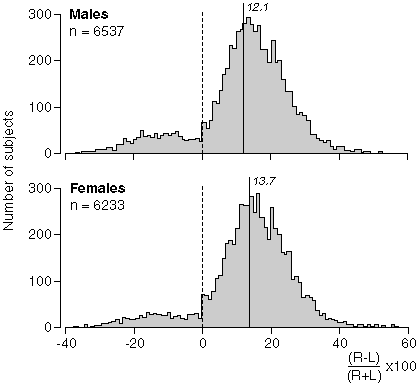
Fig. 1.(a) The distribution of relative hand skill (Relhand (R - L) /( R+L) x100) assessed as squares checked in one minute with the right (R) and left (L) hands respectively) in 12,770 individuals in the National Child Development Study (NCDS) cohort. The mean of the distribution for each sex is indicated.
Data on writing hand was recorded (at age 11 years): 11.2% of the sample wrote with their left hands. Subdivision of the population into right and left writers and by sex (Fig 1b) reveals that although there are approximately eight times as many right- as left-hand writers, the distribution of relative hand skill is approximately symmetrical around the zero point.
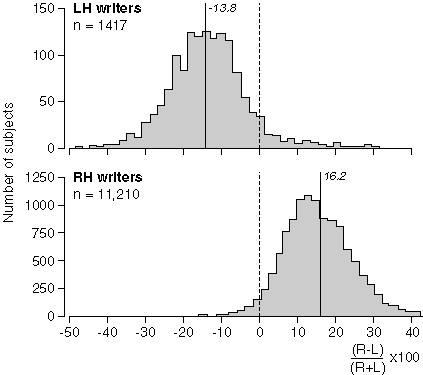
Fig. 1. (b) Relative hand skill in male and female left (LH) and right (RH) hand writers.
The findings give some support to the view that there is indeed a dichotomy of the population [34]. In each case females are more lateralised than males. The mean for female left hand writers is -13.9 and for males is -13.8 (t=0.83 p=0.41) and for right hand writers is +16.0 for males and +16.6 for females (t=4.04 p<0.0001). For both LH and RH writers there is a proportion of individuals whose scores on the relative hand skill scale are discrepant with their writing hand (96.6% of right-hand writers had scores greater than zero, and 91.4% of left-hand writers had scores less than zero), but the discreptant proportion is less in each case for females.
To assess Relhand as a predictor of academic ability the population of 5,900 males and 5,800 females who completed both tasks were divided into twenty 5-percentile bins for each sex separately. The distribution of scores on each test of ability was then examined in relation to this subdivision.
For each of the abilities (Fig 2) there were striking departures from the null hypothesis that relative hand skill and ability are unrelated. Although the general form of the deviation was similar for each ability, differences between abilities were observed that related both to degree of relative hand skill and to sex.
For verbal ability (Fig 2) there was a substantial sex difference, females performing better than males, as previously established [30], but the relationship between verbal ability and relative hand skill in the two sexes was closely similar. At the right-hand extreme there was a modest deficit (eg in bin 20) relative to those who were somewhat less strongly right-handed (in bins 13 to 18). Those in the left-hand portion of the curve did less well than those in the right-hand portion. However it was not those at the left-hand extremity who had the greatest deficits but rather those who were in bin 3, which includes the zero point of the Relhand continuum ie those individuals for whom left and right-hand skills are equal. (We refer to the point of equal hand skill as the point of "hemispheric indecision"). To the left of this point it appears that increasing degrees of left-handedness are associated with increasing verbal ability; in this analysis there is no drop-off in performance at the left-hand extremity of the Relhand continuum (but see Fig 3 and the Discussion below).
(a)
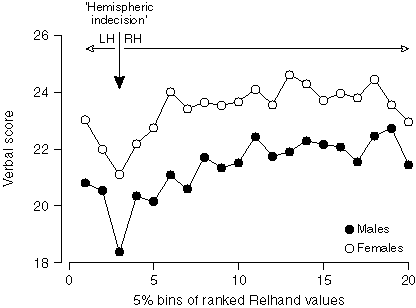
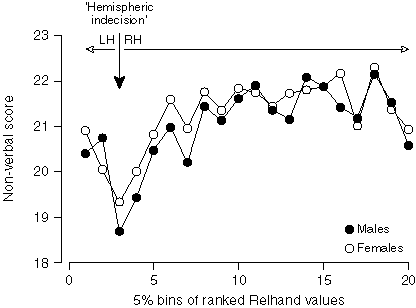
(d)
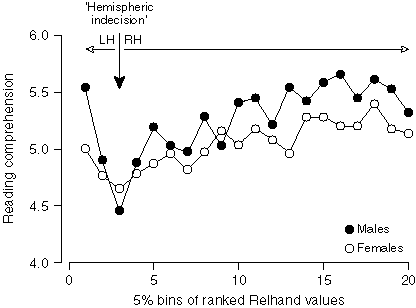
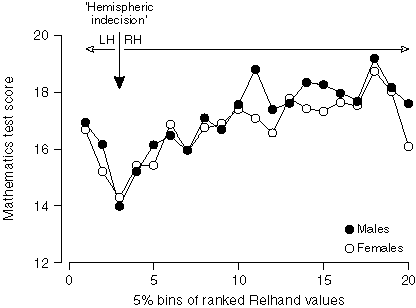
Fig 2 Relationship between cognitive abilities: a) verbal, b) non-verbal ability, c) reading comprehension and d) mathematical ability and relative hand skill (Relhand) in 11,700 individuals in the NCDS cohort for whom data was available. The population was divided into 20 five-percentile bins separately for each sex by Relhand score. Bin 3 includes the Relhand zero, ie the point of equal hand skill ("hemispheric indecision"); bins 2 and 1 include degrees of left-handedness; bins 4 to 20 include increasing degrees of right-handedness. LH - "left-handers"; RH - "right-handers" by hand skill.
For non-verbal ability (Fig 2) the sex difference is absent, while the general form of the curve is similar. Again the greatest deficit is in bin 3, with relative deficits in adjacent bins. There is a somewhat greater decrement than in the case of verbal ability at the right-hand end of the continuum. For reading comprehension there is negligible deficit at the right extremity, but again there is a sex difference with males performing better than females except at the point of equal hand skill where the trough for males is greater than for females. For mathematical ability in contrast to the pattern for reading ability there is a substantial decrement in strong right-handers (greater for females) relative to those who are clearly right-handed but less strongly so. Multiple regression analysis revealed linear, quadratic and cubic effects. There were no quartic trends significant at the 0.05 level of probability, but for each ability there was a quintic trend (p<0.001).
To examine whether the deficits at the point of equal hand skill might be attributable to a sub-group in whom hand skill in general was impaired we re-examined the relationships between Relhand and cognitive abilities after eliminating the lowest tenth percentile of the R+L (total squares marked with the right and left hands) distribution. The deficits in ability around the point of equal hand skill were essentially unchanged. This procedure also appears to control for the conjecture that individuals close to the point of equal hand skill are less motivated.
We examined verbal and non-verbal ability in relation to relative hand skill separately in the populations of left- and right-hand writers as defined in the distributions in Fig 1b. In this analysis we employed a LOWESS exponential smoothing function [11], with 50% of points filled and three iterations.. The findings (Fig 3) suggest a relationship between Relhand and cognitive function that is more symmetrical around the point of hemispheric indecision than is apparent in the percentile analysis (Fig 2). The relationship between relative hand skill and verbal and non-verbal ability in the two populations is similar with optimal ability in the middle of the range, lesser ability at each handedness extreme, and deficits around zero and in the group of individuals in whom there is a discrepancy between writing hand and direction of relative hand skill. In as far as writing hand can be taken as an index of dominance it appears that similar relationships hold between degrees of dominance and the development of verbal and non-verbal skills in either hemisphere. However the form of the relationship in right-hand writers is more complex than in left-hand writers.
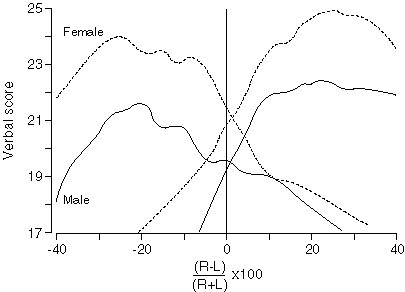
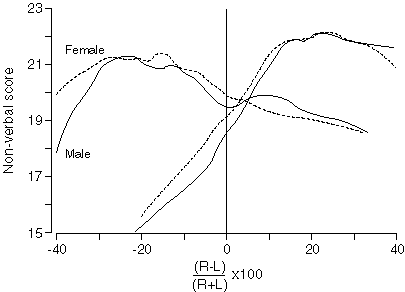
Fig 3 Relationship between ( a) verbal, and b) non-verbal ability, and relative hand skill (Relhand) in left- and right-hand writers in 11,700 individuals in the NCDS cohort for whom data at age 11 years was available. The curves have been smoothed with a Lowess function and truncated at Relhand values of +40 and -40, or where the numbers of individuals at a particular Relhand value discrepant with writing hand became too small to sustain the function.
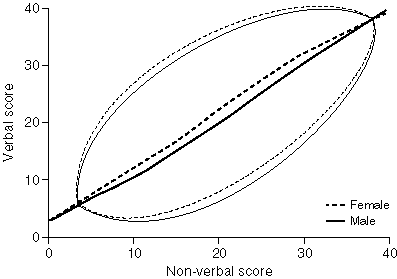
Fig 4 Relationship between verbal and non-verbal ability in males and females. The envelopes outline the bodies of points in the two sexes.
Discussion
The findings yield decisive disconfirmation of the null hypothesis that relative hand skill and cognitive ability are unrelated. Across abilities and sex the relationship is consistent: whilst at the extremes of hand skill there are modest decrements that are sex and ability dependent, the most substantial deficits are close to the point of equal hand skill or hemispheric indecision. From Figs 2 and 3 it appears that it is failure to establish dominance unequivocally in one or the other hemisphere that is problematic. Those that have failed to do so, at least by the age of 11 years, are globally delayed in their development relative to their peers. Previous failures to demonstrate robust and consistent relationships between handedness and cognitive ability [5,8,26,44] may be attributable to the treatment of handedness as a dichotomous rather than a continuous variable or to inadequate subdivision of the handskill continuum [39,40]. Although the findings may be construed as supporting the theory of a balanced polymorphism relating handedness to cognitive ability they are not readily assimilated to existing genetic concepts. Annett’s [1,2] balanced polymorphism development of the bi-allelic theory (a single gene, the right shift factor, acting together with a random influence biases the left hemisphere to be dominant) predicts the modest deficits that are observed at the extremes of hand skill but fails to predict the major deficits that are distributed around the point of equal hand skill. These deficits are consistent with the concept of Orton [37] and Zangwill [45] that ambidexterity reflecting "cerebral ambilaterality" [22] itself is associated with a delay in development (see also Bishop [5] p124-125 table 11.1), but this concept is not encapsulated in existing genetic models.
The symmetry of the distribution of Relhand in left and right-hand writers (Fig 1b), and the relationships with verbal and non-verbal ability demonstrated in Fig 3, are consistent with the concept there is an optimum of lateralisation away from the point of equality [28], and that this optimum is of approximately similar magnitude whether it is in the left or right hemisphere. A bimodal distribution of dominance and its correlates might account for some of the complexity of the relationships (eg the cubic and quintic trends) presented in Fig 2. Such bimodality might be accounted for by a random bias in the course of development to one or other hemisphere. What cannot be explained by a random influence is the excess of right handers in the population (approximately 89% by writing hand) or evidence that handedness is inherited [1,13,34]. It appears there is a genetic influence, and that the influence may be specific to Homo sapiens [33] but its nature is as yet obscure. Some complexities in the form of the curves in the left and right hand segments in fig 3 may be relevant - these suggest a possible influence of multiple alleles. While the bi-allelic theories of Annett [1] and McManus [34] provide an explanation of the excess of right handers in the population, and the transmission of handedness within families, it is unclear that either of these theories can account for the complexity of the relationship between degrees of hand skill and ability that is apparent in our findings. We think the findings are more readily explained by a locus that influences degree of lateralisation as well as its direction. Gangestad & Yeo [21] have argued for a genetic influence on degree of handedness but on the basis of a polygenes rather than a single locus.
The pattern of deficits across abilities suggests ways in which relative hand skill influences development. The decrement at the right-hand extreme for non-verbal and mathematical ability relative to verbal ability suggests that some aspect of spatial processing is vulnerable to a strong lateralisation pressure eg as in Annett's rs++ genotype (strong right-handers). Reading ability is not susceptible to this influence. The striking advantage (independent of relative hand skill) of females over males with respect to verbal ability contrasts strongly with the mean male advantage (dependent upon relative hand skill) for reading ability. In terms of the overall sex difference in Relhand (Fig 1) one might suppose that stronger (or possibly earlier) lateralisation facilitates the development of the vocabulary, whereas the relationship to reading ability is more complex. Perhaps if reading ability depends upon a spatial component (better in later lateralising, or less lateralised males) as well as a phonological component (that is vulnerable to delay in hemispheric differentiation) it might be possible to explain the overall male advantage as well as the particular male deficit at the point of hemispheric indecision.
Thus the deficits or delays associated with hemispheric indecision have potential relevance to pathology. Some forms of reading disability may as first proposed by Orton [37] be associated with failure to allocate dominance unequivocally to one hemisphere, and the preponderance of dyslexia and language disabilities in general in males may be attributable to the lesser degree of lateralisation that is evident in relative hand skill at the age of 11. That "hemispheric indecision" has wider implications is suggested by our observation that a group of children in this cohort who were later found to have developed schizophrenic illnesses differed significantly from the cohort as a whole in being less lateralised on the Relhand index at age 11 years, and having been more likely to be rated as ambidextrous by a parent at age 7 [19]. Such illnesses are associated with a procreative disadvantage [31,43]. If indeed they are associated with variation at a locus for cerebral lateralisation the continued high and universal prevalence in human populations raises the question of why the relevant alleles are not selected out [15,18].
Differences between the sexes in relative hand skill (Fig 1) are of interest in relation to the differences between the sexes in the distribution of abilities - females generally showing greater mean verbal fluency and males spatial ability [25,30,32] Within this population the consistency and size of the sex difference in cognition is apparent in the plot of verbal against non-verbal ability, females having a two point advantage over males across the distribution (Fig 4). It has been suggested [15,16] that the right-shift factor, or cerebral dominance gene, is in the class that is present in homologous form on both the X and Y chromosomes. In support of this conjecture are
i) observations on the psychological deficits associated with sex chromosome aneuploidies: XO, or Turner's syndrome individuals show non-dominant (ie spatial) and XXY (Klinefelter's), and XXX syndrome individuals show left-hemisphere (verbal), deficits. These findings suggest that a gene influencing relative hemispheric development is present on the X chromosome. The absence of deficits comparable to Turner's syndrome in males indicates that a balancing gene is present on the Y chromosome.
ii) an association within sibships between handedness and sex that is weak but consistent in magnitude with that predicted by the Annett and McManus theories [14].
Such genes are subject to relatively rapid evolutionary change [27,38]. Because outside the pseudoautosomal (exchange) region recombination between X and Y chromosomes does not occur, sequence divergence between X and Y copies of the gene will be expected and could account for a sexual dimorphism such as is seen in relative hand skill (Fig 1) and its effects on verbal ability (Fig 2). In so far as there is differential expression of the gene in the two sexes it will be subject to sexual selection, ie the effects of differing criteria [7], or timing [15], of mate choice in the two sexes.Such selective influences will determine the range of variation maintained separately in the populations of males and females. These in turn will exert their effects through actions on the rate and degree of lateralisation. Thus the sex difference in the rate of maturation may be secondary to the fact that mate choice (for optimal features of the species characteristic of language) occurs at a later age in males than females (males are one to two years older than females at the time of marriage a difference that is consistent across cultures [15]).
The hypothesis that a gene for cerebral dominance is present in homologous form on X and Y chromosomes has been discussed by Corballis [13] who concludes that such a location will account for evidence of weak linkage between sex and handedness [14] and might explain a sexual dimorphism for cerebral asymmetry. However in modelling survival under selection he concludes that given father-to-son transmission of the Y chromosome the polymorphism on the Y that is required by theory will under reasonable assumptions be lost from the population. It should be noted however that persisting variation might be generated by an unstable genetic locus, eg one associated with a tandem repeat, and that such loci are known to be present in the region of the Y chromosome with homology to the X [10]. Thus while we are not able to specify in detail an alternative to the bi-allelic models of Annett and McManus we think that a model in which the variation arises from a high mutation site (rather than a balanced polymorphism) and that is located in a region of homology between X and Y chromosomes (thus accounting for hitherto unexplained sex differences) deserves consideration.
We note that a recent study of the inheritance of verbal ability (assessed with the Moray House test at the age of 11 years) in 4,383 Orkney children reached the conclusion that the trait was X-linked [24] and that nine phenotypes were present in males [23].
The relationships we observe are consistent with a major role for a gene influencing hemispheric differentiation in determining cognitive ability. In the sense that the abilities are specifically human and of potential survival value, and that some "genotypes" may be associated with a biological disadvantage (see Discussion para 4 above), the relevant gene appears to be under continued evolutionary selective pressure. It relates to the speciation characteristic of language [1,2,4,12]. The change (eg a chromosomal transposition or inversion) on the sex chromosomes that generated the diversity that allowed language to evolve is a candidate for the speciation event in the evolution of Homo sapiens [17].
Acknowledgments
This study was supported by the UK Medical Research Council. We thank J Bynner and P Shepherd for their help with the NCDS data set and M Annett, DVM Bishop, IC McManus for comments on aspects of the analysis.